| Photos by Penny O'Connor | |
|
Western Cuyahoga Audubon Society
“Vision 2020” for the Rocky River IBA
April 28, 2010
I. Areas of
Concentration
II. Development of Top
Areas of Interest.
2.
Educate private landowners.
3.
Track invasives outside of Metroparks.
4.
Identify the right partners for each function.
5.
Benchmark West Branch group.
6.
Actively talk with partner/with municipalities.
7.
Identify neighborhood groups
to talk with.
8.
Contact individual landowners.
9.
We should know development plans/issues of communities in the
IBA.
10. Prioritize units
within IBA for close attention.
11.
Committees
that focus on specific units.
12. Advocate for
Riparian ordinances within the IBA, especially headwaters.
13. Find out the
riparian ordinances that exist right now in the IBA, especially
headwaters.
A. Determine
enforcement.
B. How are
requests for variances administered?
2.
Monthly hikes, activities in the IBA.
3.
Focus on increasing membership in the IBA communities.
4.
Get to groups, schools, etc. about changes they can get
behind.
5.
Enviro-festival.
6.
Promote walks, activities in schools.
7.
Offer Earth Day presentations to schools.
8.
Develop outreach to neighborhood associations.
9.
Attend council/trustee meetings and reviews of variances.
10. Door-to-door
canvassing.
11. Facebook page.
12. Outreach to
churches.
13. Outreach to science
clubs, enviro clubs.
14. Outreach to colleges
– clubs, groups, - Baldwin-Wallace.
15. Our events in local
papers, Mimis.
16. Develop our
“Marketing Case.”
17. Outreach to other
outdoor groups.
18. Actively support
activities of similar groups
19. Communicate/promote
activities/events of partners/similar groups.
20. Focus monthly
meetings on IBA.
21. Get other groups out
for our watershed walk – Ultra Walk.
22. Production of a
video.
November 16, 2009
DEVELOPMENT
The goal is to organize a development plan that will provide for the
implementation and continuation of conservation in the Rocky River
IBA, and be, in turn, a driver of economic support for eco-tourism
and land conservation.
We will know when we have achieved this goal when a centralized
source of potential funders exists, a cadre of trained and motivated
fund-seekers is in place, and a target of annual revenue with
associated target programs has been established.
Measurable objectives to achieve this goal are as follows:
1. Form a development committee comprised of people from the other
IBA committees.
2. Recruit a cadre of
fund-seekers to train and motivate to raise earned income and seek
grants
3. Coordinate with
other IBA committees for target projects and funding requirements.
LAND ACQUISITION, CONSERVATION, AND RESTORATION
The goal is to conserve and restore the riparian corridor of the
Rocky River IBA, its associated high-quality habitats, and critical
headwater catchments.
In addition, this plan will acquire appropriate habitats that will
maintain healthy ecosystems and stable bird and wildlife populations
in the IBA. We will
know when we have achieved this goal when protected lands of high
ecological value are connected along the entire IBA; the area of
protection has expanded; invasive species have been removed; and
significant restoration of wetlands, meadow, and stream corridors
has been completed.
Measurable objectives to achieve this goal are as follows:
1. Develop a land
acquisition plan that preserves critical land, identifies willing
sellers, and works in partnerships with other agencies.
2. Develop a
conservation and restoration plan that specifies management goals
and collects baseline ecological data.
EDUCATION AND STEWARDSHIP
The goal is to foster personal responsibility through awareness of
each citizen being a part of the IBA and the
1. Ensure that state
schools have relevant curriculum.
2. Neighbor activities
for public involvement are in place.
PARTNERSHIPS
The goal embraces various governmental agencies, community groups,
and concerned citizens.
By 2020, all parties interested in the health of the Rocky River IBA
will, using their various talents and special interests, be working
toward a greater appreciation and awareness of this special
ecosystem by the general public.
We will know we are moving toward our goal when the watershed
is healthier tomorrow than it is today, and the public embraces and
joins our efforts.
Measurable objectives to achieve this goal include:
1. Enlist community
organizations and citizens in working toward this goal.
2. Enlist governmental
bodies in working toward the goal.
3. Conduct outreach
efforts to schools, scout groups, and other special groups.
PRACTICES AND POLICIES
The goal is to involve communities in practices and policies that
protect and promote habitat conservation.
We will know when we have reached this goal when regional
boards of governance have been set up with their own conservation
goals, and state-wide land use planning policies that promote these
conservation goals have been established.
Measurable objectives to achieve this goal include:
1. Identify common
community goals for riparian setbacks and open space planning and
zoning.
2. Identify
complimentary stakeholders with a similar vision who will mutually
coordinate goals, objectives, and projects.
3. Work with counties
and the state on actions to implement policies.
APPLIED RESEARCH
By 2020, we will have assessed habitats throughout the IBA by
increasing volunteerism to expand our research and monitoring.
We will use the results to inform and persuade decision
makers, such as legislators, city planners, and public and private
landowners. We will
know when we have reached our goal when this set of data is cited as
the determinate factor in wise land use decisions.
Measurable objectives to achieve this goal include:
1. Identify and
prioritize habitats to be surveyed.
2. Hire a person to
coordinate volunteers and interface with communities.
3. Continue the
collection of data through bird surveys.
4. Hire researchers to
analyze the data and publish results (such as a graduate student
project.
5. Convert the
published results into sellable ideas.
6. Disseminate the
ideas broadly and strategically to target audiences.
MARKETING THE IBA
By 2020, we will have a marketing plan that identifies who’s in
charge, what we do, where our money comes from, and how we
communicate. We will
know when we have achieved this goal when a document exists and we
routinely follow it.
Measurable objectives to achieve this goal include:
1. We are recognized
nationally as a model IBA.
2. Everyone who lives
and recreates in the IBA knows what it is and why it is important.
3. We make use of
up-to-date technology to communicate with stakeholders.
|
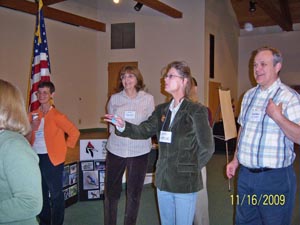 Brainstorming Vision 2020 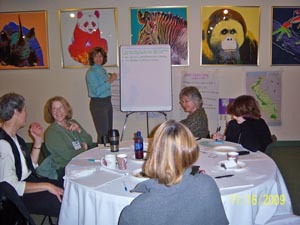 More brainstorming 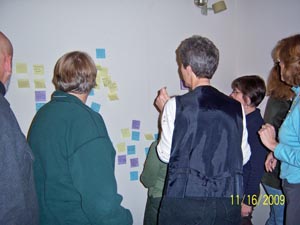 Storyboarding at Vision 2020 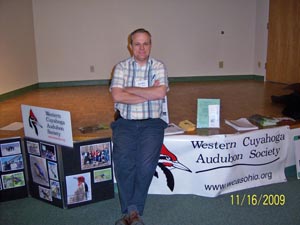 Rick Bohan our Facilitator 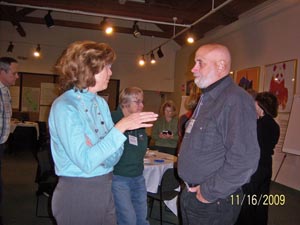 Meaningful discussions. |
























